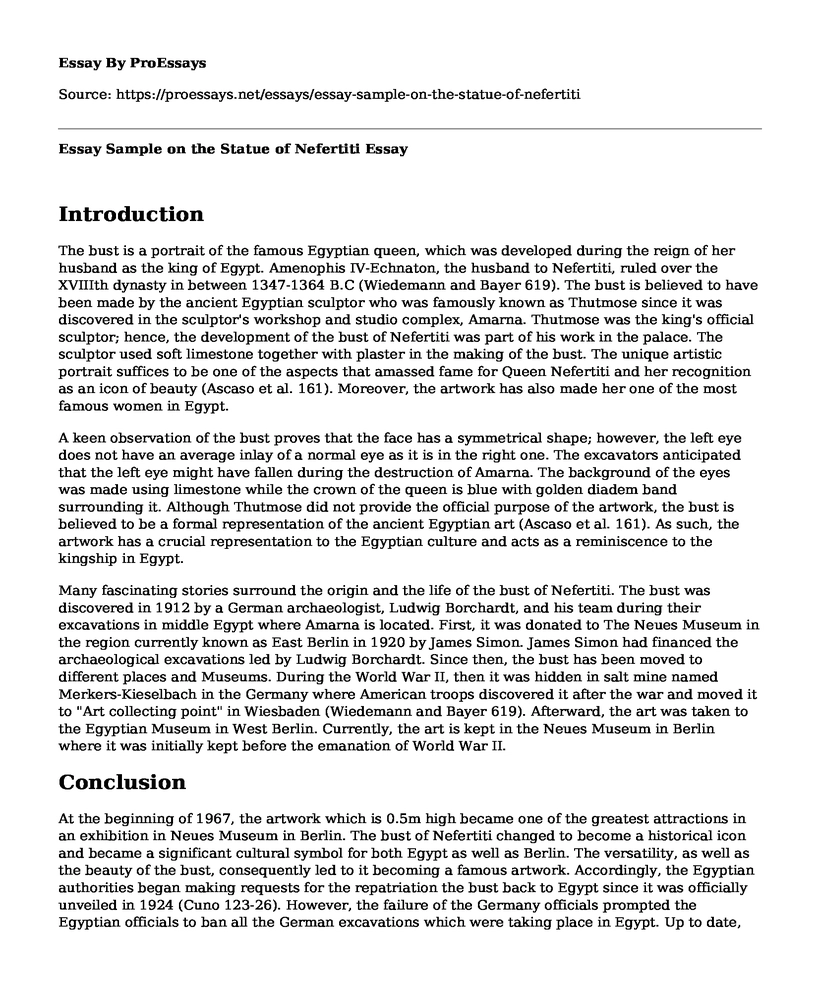Introduction
The bust is a portrait of the famous Egyptian queen, which was developed during the reign of her husband as the king of Egypt. Amenophis IV-Echnaton, the husband to Nefertiti, ruled over the XVIIIth dynasty in between 1347-1364 B.C (Wiedemann and Bayer 619). The bust is believed to have been made by the ancient Egyptian sculptor who was famously known as Thutmose since it was discovered in the sculptor's workshop and studio complex, Amarna. Thutmose was the king's official sculptor; hence, the development of the bust of Nefertiti was part of his work in the palace. The sculptor used soft limestone together with plaster in the making of the bust. The unique artistic portrait suffices to be one of the aspects that amassed fame for Queen Nefertiti and her recognition as an icon of beauty (Ascaso et al. 161). Moreover, the artwork has also made her one of the most famous women in Egypt.
A keen observation of the bust proves that the face has a symmetrical shape; however, the left eye does not have an average inlay of a normal eye as it is in the right one. The excavators anticipated that the left eye might have fallen during the destruction of Amarna. The background of the eyes was made using limestone while the crown of the queen is blue with golden diadem band surrounding it. Although Thutmose did not provide the official purpose of the artwork, the bust is believed to be a formal representation of the ancient Egyptian art (Ascaso et al. 161). As such, the artwork has a crucial representation to the Egyptian culture and acts as a reminiscence to the kingship in Egypt.
Many fascinating stories surround the origin and the life of the bust of Nefertiti. The bust was discovered in 1912 by a German archaeologist, Ludwig Borchardt, and his team during their excavations in middle Egypt where Amarna is located. First, it was donated to The Neues Museum in the region currently known as East Berlin in 1920 by James Simon. James Simon had financed the archaeological excavations led by Ludwig Borchardt. Since then, the bust has been moved to different places and Museums. During the World War II, then it was hidden in salt mine named Merkers-Kieselbach in the Germany where American troops discovered it after the war and moved it to "Art collecting point" in Wiesbaden (Wiedemann and Bayer 619). Afterward, the art was taken to the Egyptian Museum in West Berlin. Currently, the art is kept in the Neues Museum in Berlin where it was initially kept before the emanation of World War II.
Conclusion
At the beginning of 1967, the artwork which is 0.5m high became one of the greatest attractions in an exhibition in Neues Museum in Berlin. The bust of Nefertiti changed to become a historical icon and became a significant cultural symbol for both Egypt as well as Berlin. The versatility, as well as the beauty of the bust, consequently led to it becoming a famous artwork. Accordingly, the Egyptian authorities began making requests for the repatriation the bust back to Egypt since it was officially unveiled in 1924 (Cuno 123-26). However, the failure of the Germany officials prompted the Egyptian officials to ban all the German excavations which were taking place in Egypt. Up to date, the art has not been returned to Egypt. German argues that the bust of Nefertiti is just a single piece of art in foreign nations; hence, the Egyptians should first focus on all other pieces of art and not just target the bust.
Works Cited
Ascaso, Francisco J., et al. "One-eyed beauty: Queen Nefertiti's bust." British Journal of Ophthalmology 95.2 (2011): 161-161.
Cuno, James. "Culture War: The Case Against Repatriating Museum Artifacts." Foreign Affairs 93.6 (2014): 119-129.
Wiedemann, Hans Georg, and Gerhard Bayer. "The bust of Nefertiti." Analytical Chemistry 54.4 (1982): 619-628.
Cite this page
Essay Sample on the Statue of Nefertiti. (2022, Oct 19). Retrieved from https://proessays.net/essays/essay-sample-on-the-statue-of-nefertiti
If you are the original author of this essay and no longer wish to have it published on the ProEssays website, please click below to request its removal:
- Critical Essay on Frederick Douglass Speech: Black America Vision
- Unlawful Containment of U.S Citizens: Japanese Internment Camps
- Importance of Florentine Medici Family in Renaissance Art Essay
- A Sociological Analysis of the Roles of Institutions in Slavery to Make It Function
- Mid-20th Century US: Changes in Culture, Economy, Population - Essay Sample
- Paper Example on Rafe & Danny: Best Friends in War-Torn Times
- Unique American Culture: Religion & Belief Tolerance - Essay Sample







